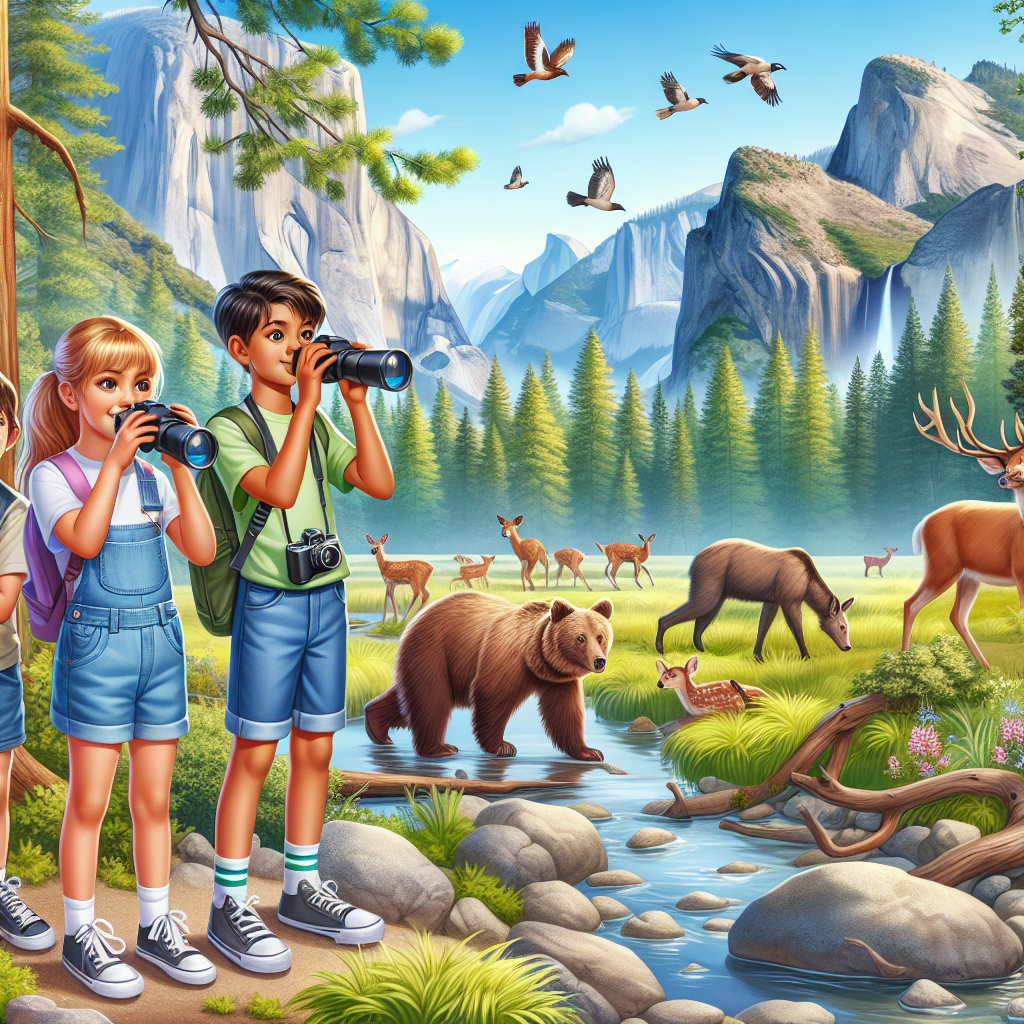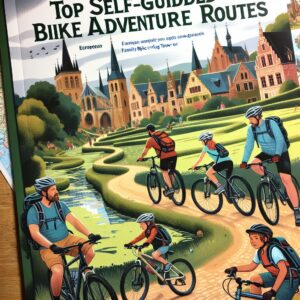
Article-at-a-Glance
-
Discover the essential gear for a comfortable and successful wildlife viewing trip with your family.
-
Learn about the top destinations within Yosemite for encountering diverse wildlife.
-
Explore the best trails for families to maximize their chances of spotting animals in their natural habitat.
-
Understand the importance of timing and how it affects wildlife activity in the park.
-
Gain tips on how to engage children in educational activities that enhance their wildlife viewing experience.
Preparation is Key: Gear up for Yosemite Wildlife Encounters
Before embarking on your unforgettable journey to Yosemite with the kids, it’s crucial to pack smartly. The right equipment can make all the difference in spotting a black bear in the distance or a deer grazing nearby. Here’s how to gear up for the ultimate family wildlife adventure.
Choosing the Right Binoculars for Little Explorers
Binoculars are a must-have for any wildlife watching, but when it comes to kids, durability and ease of use take center stage. Look for compact, lightweight models with rubber coatings to withstand drops and bumps. Opt for binoculars with a magnification of 8x to 10x – powerful enough to see details but still easy to hold steady. Make sure they have a wide field of view to catch fast-moving critters.
Comfortable Hiking Clothes for All-Day Adventures
Dress your troop in layers that can be easily added or shed as temperatures fluctuate throughout the day. Quick-dry fabrics are ideal, and don’t forget a waterproof jacket in case of sudden showers. Sturdy, comfortable hiking shoes are non-negotiable – they’ll provide the support and grip needed for those off-trail explorations.
Snacks and Water: Essential for Maintaining Energy
Keep energy levels high with plenty of snacks and water. Trail mix, granola bars, and fruit are perfect for on-the-go munching. Hydration is key, so pack refillable water bottles for each family member. And remember, Yosemite is bear country, so all food items should be stored in bear-proof containers when not in use.
Where the Wild Things Are: Top Spots for Animal Sightings
Yosemite is a vast wilderness home to countless species, each with their preferred hangouts. To maximize your wildlife viewing opportunities, you’ll want to know where to go.
Yosemite Valley’s Meadow Loop: Deer and Bird Paradise
The meadows of Yosemite Valley are a hotspot for deer, especially in the early morning and late afternoon. The open spaces also provide excellent birdwatching opportunities. Keep your eyes peeled for the flash of a Steller’s jay or the majestic soar of a golden eagle.
Glacier Point’s Breathtaking Vistas and Wildlife
Glacier Point offers not only some of the park’s most iconic views but also chances to spot wildlife. From here, you may see marmots sunning on rocks or hear the call of a Clark’s nutcracker echoing through the air.
Example: During a family hike to Glacier Point last summer, we were thrilled to watch a family of marmots playing near the overlook. Their antics provided entertainment and a perfect teaching moment about alpine wildlife.
Wawona: A Sanctuary for Squirrels, Birds, and Bears
Wawona, with its mix of dense forests and open meadows, is an ideal place for families to observe Yosemite’s diverse wildlife. The area’s Giant Sequoias are not only awe-inspiring but also a habitat for countless birds and smaller mammals. And yes, bears do wander through, so always be bear-aware!
Walk on the Wild Side: Kid-Friendly Trails for Maximum Wildlife Viewing
Yosemite’s trails are as diverse as the wildlife that inhabits them. Here are a couple of trails that promise a high likelihood of animal encounters while being manageable for little legs.
The Lower Yosemite Fall Trail: An Easy Stroll with High Chances of Wildlife
This short loop trail is perfect for families. It’s an easy walk that leads to the base of Yosemite Falls, where you’re likely to spot squirrels, and if you’re lucky, even a bobcat slinking through the underbrush.
Mariposa Grove: Majestic Sequoias and Their Inhabitants
Mariposa Grove is home to hundreds of ancient giant sequoias, and where there are trees, there’s wildlife. Walking among these giants, you’re bound to encounter a variety of birds and might even come across some of the park’s more elusive creatures, like the great gray owl.
Getting to Know Yosemite’s Ecosystems Through Exploration
Every adventure in Yosemite is a chance to teach your kids about the delicate balance of nature. As you traverse through different habitats, from the valley meadows to the high sierra, explain how each ecosystem supports its own unique set of wildlife. This understanding deepens the appreciation of every creature they spot, big or small.
For example, while walking through a meadow, you might explain how the open space allows for certain plants to thrive, which in turn attracts herbivores like mule deer, and following them, predators such as mountain lions. It’s a chain of life, right before their eyes.
Moreover, understanding these ecosystems helps kids grasp the importance of conservation. Explain that each action we take, from staying on trails to properly disposing of trash, helps preserve these habitats for future generations.
Interactive Games: Learning Wildlife Facts Can Be Fun
Turn the quest for wildlife into an interactive game. Create a bingo card with animals and plants you might encounter in Yosemite. Each sighting allows for a checkmark, and a full row means a special treat or a fun reward. This keeps the kids engaged and on the lookout for wildlife, making the hike more exciting.
When to Watch: Timing Your Visits for Optimal Wildlife Encounters
The time of day can significantly impact your chances of encountering wildlife. Animals are most active during the cooler parts of the day, so plan your outings accordingly. Early morning and late afternoon are your best bets for sightings.
Moreover, consider the season. Spring is a time of renewal, with many animals emerging with their young. Summer, though busier, still offers ample viewing opportunities, especially in the higher, less crowded areas. Fall brings a change in behavior as animals prepare for winter, and even in the quiet of winter, there’s wildlife to be spotted against the serene, snowy backdrop.
Dawn and Dusk: The Golden Hours for Wildlife Viewing
The soft light of dawn and dusk not only makes for stunning photographs, but it’s also when wildlife is most active. Creatures like deer and coyotes are crepuscular, meaning they’re out and about at twilight. Plan to be at your viewing spot during these times, and you might just witness the forest come alive.
Seasonal Spectacles: What to Expect Throughout the Year
Each season in Yosemite offers a unique wildlife experience. In spring, watch for baby animals and blooming wildflowers. Summer is great for spotting high-elevation dwellers like pikas and marmots. Come fall, keep an eye out for the black bears foraging in preparation for winter, and in winter, look for tracks in the snow or catch a glimpse of the elusive bobcat.
Also, remember that some areas of the park, like Tioga Road, are closed during winter due to snow, so plan your wildlife viewing around these seasonal closures.
Keep It Safe: Rules of Wildlife Engagement
While it’s thrilling to see animals in their natural habitat, safety is paramount. Teach your children the importance of observing wildlife from a safe distance. Never approach, feed, or try to touch wild animals. Not only is it dangerous, but it can also disrupt their natural behaviors.
Observe From a Distance: Safety for You and the Animals
Always stay at least 100 yards away from bears and wolves, and at least 25 yards away from all other wildlife. Use your binoculars or a telephoto lens to get a closer look. Remember, we’re visitors in their home, and we should respect their space as we would want ours respected.
What to Do if You Encounter a Bear or Other Large Mammals
If you do encounter a bear, stay calm. Do not run; instead, slowly back away while facing the bear. Make yourself appear as large as possible and make noise to intimidate the bear. Always carry bear spray as a precaution and know how to use it.
In the rare event of a mountain lion sighting, do not crouch or bend over. Pick up small children immediately, and do not run. Instead, stand tall, wave your arms, and speak loudly. If attacked, fight back.
These encounters are very rare, but it’s important to be prepared and knowledgeable about what to do. Most importantly, these experiences teach kids respect for wildlife and the understanding that we must coexist peacefully.
Creating Memories: Capture Yosemite’s Wildlife with Your Camera
Photography is a wonderful way to preserve your family’s wildlife encounters. Encourage your kids to take their own pictures, which not only captures the moment but also helps them focus on observing details.
Tips for Kid-Friendly Nature Photography
Equip your kids with a simple, durable camera and teach them the basics of wildlife photography: patience, silence, and observation. Show them how to frame a shot and encourage them to take photos from different angles. Remind them that sometimes, the best photo is the one taken with their eyes, stored in memory.
Scrapbooking Your Adventure: A Fun Post-Trip Activity
Once home, creating a scrapbook of your adventure is a fun way to relive the experience. Include photos, drawings, and even leaves or pressed flowers collected from the ground (never picked from plants). This not only cements the memories but also reinforces the lessons learned about nature and wildlife.
Yosemite’s Nighttime Residents: Evening Wildlife Adventures
When the sun sets, a different cast of characters emerges in Yosemite. Participating in a ranger-led night prowl or simply sitting quietly by your campsite can reveal the nocturnal habits of owls, bats, and even mountain lions.
Night Prowl Programs: Discovering Nocturnal Creatures
Ranger-led programs offer a safe and educational way to explore Yosemite after dark. These programs often include activities like listening for owl calls or watching for the glowing eyes of deer in the darkness. It’s a thrilling experience that can spark a lifelong interest in nocturnal wildlife.
Stargazing and Storytelling: The Perfect End to Your Day
After your nighttime wildlife adventure, cap off the evening with stargazing. Yosemite’s clear skies are perfect for observing constellations and shooting stars. Share stories of the day’s sightings and discuss the wonders of the universe. It’s moments like these that deepen our connection to the natural world and to each other.
Junior Ranger Programs: Badges of Honor for Young Naturalists
The Junior Ranger programs in Yosemite are an excellent way for kids aged 7 to 13 to learn about the park’s wildlife and ecosystems. By completing activities and attending ranger-led walks, they earn badges, making them feel like true protectors of nature. It’s a fun and educational experience that instills a sense of responsibility and achievement.
Wee Wild Ones Activities: Engaging the Youngest Explorers
For the younger adventurers, Yosemite offers the Wee Wild Ones program, featuring activities tailored to kids under 7. Through games and storytelling, they learn about the park’s animals and plants in a way that’s engaging and age-appropriate. These early experiences can foster a lifelong love for wildlife and the outdoors.
Considerate Travel: Ensuring Yosemite’s Wildlife Future
As visitors to this magnificent park, we have a duty to leave it as pristine as we found it. Educating our children on the importance of considerate travel ensures Yosemite’s wildlife and habitats remain unspoiled for future generations to enjoy.
Leave No Trace Principles: Educating Kids on Conservation
Instill in your children the Leave No Trace principles: pack out what you pack in, stay on trails, and respect wildlife. By practicing these simple rules, we minimize our impact on the environment and protect the natural behaviors and habitats of the animals we come to observe.
Supporting Preservation Efforts Through Responsible Tourism
Support Yosemite’s preservation by engaging in responsible tourism. This includes staying in designated areas, participating in educational programs, and considering donations to conservation efforts. By doing so, we contribute to the park’s health and vitality, ensuring it remains a haven for wildlife and a place of wonder for all who visit.
FAQs
Got questions? Here are some quick answers to commonly asked questions about wildlife viewing in Yosemite with kids.
What’s the best time of year for wildlife viewing in Yosemite?
The best time for wildlife viewing in Yosemite is spring and early summer when animals are most active. However, each season offers unique viewing opportunities, so plan your visit based on the type of wildlife you hope to see.
Are there any dangerous animals we should be aware of?
While Yosemite is home to bears and mountain lions, encounters with these animals are rare. Always keep a safe distance from all wildlife and educate yourself and your family on how to behave if you encounter a larger animal.
What kind of wildlife can we expect to see in Yosemite with kids?
In Yosemite, you can expect to see a variety of wildlife, including deer, squirrels, birds, and with some luck, bears or bobcats. Each area of the park has different species, so visit various habitats to see a wide range.
How do we prepare our kids for a wildlife viewing hike?
Prepare your kids by teaching them about the animals they might see, the importance of silence and patience, and the need to respect nature. Equip them with binoculars and snacks, and make sure they’re dressed for the weather and terrain.
Are there ranger-led programs suitable for very young children?
Yes, Yosemite offers ranger-led programs for all ages, including the Wee Wild Ones activities for children under 7. These programs are designed to be fun and educational, introducing the youngest visitors to the wonders of the park.
Yosemite’s wildlife is a treasure that, when explored with care and respect, can provide a lifetime of memories for you and your family. By preparing properly, choosing the right trails, and engaging in educational activities, your visit to Yosemite will be filled with awe-inspiring encounters with the natural world. Whether you’re watching a deer graze at dawn, listening to an owl’s call at night, or earning a Junior Ranger badge, each moment spent in this majestic park is an opportunity to foster a deeper appreciation for wildlife and the importance of preserving our natural heritage.



